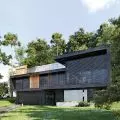Interview from A&B issue 11|2022
The first installment of a two-part series on the set design for the play "1989," directed by Katarzyna Szyngiera, a co-production of the Juliusz Słowacki Theater in Krakow and the Shakespeare Theater in Gdansk. We talk with Milena Czarnik, the show's set designer, about the inspiration, challenges in working on the project and supervising its execution.
Milena CZARNIK - choreographer, stage designer, costume designer, lighting director. Associated with the theater since 1993. First as an actress and dancer at the Dada von Bzdülöw Theater in Gdansk and the City Theater in Gdynia, and since 2000 as an independent dancer, choreographer and stage designer she has been realizing her own stage andoutdoors and collaborates in the production of films (set designer for Przemysław Wojcieszek's "Secret", shown at the Berlin International Film Festival, and Katarzyna Szyngiera's "Border"), music videos (Blenders, Crew, Formacja Nieżywych Schabuff, Polaczek) and fashion shows. Since 2005, he has worked in dramatic theaters. He has worked with Monika Strzępka, Justyna Łagowska, Katarzyna Szyngiera, Anna Radwan, Marcin Czarnik, Łukasz Gajdzis, Jakub Krofta and Maria Wojtyszko, among others, and since 2017 with the Lodz-based Tartak Group. In 2019, the play she co-created with Marcin Czarnik - "What Bites Gilbert Grape". - received the Grand Prix of the 37th Festival of Theater Schools in Lodz, and in 2020 it won recognition from the author of the book himself, Peter Hedges.
Agata Schweiger: Tell us, please, what the design process was like. Did you work together with the director [Katarzyna Szyngiera - editor's note], holding meetings, or is it solely your idea? And also, is this project based on the first idea, or is it the result of a process? What was the inspiration for its creation?
Milena Czarnik: When Kasia came up with a proposal to create a set design for a musical, what's more - happening in the 1980s, it was an offer that could not be refused. A difficult task, of course, but I like challenges. This is already our fourth collaboration. Each time we brainstorm and come up with the main ideas together. If we like any idea, we develop and refine it. We came up with this particular one while walking around the Royal Baths. Originally, the main set design idea was an apartment block inspired by the famous Danzig wave building, which was to split in two at some point, revealing an industrial shipyard space. The budget and the need to design a set adapted to the technical requirements of two stages as different as those of the Slowacki Theater in Krakow and the Shakespeare Theater in Gdansk forced me to change the concept, but I think to my advantage.
Juliusz Słowacki Theater in Krakow
photo: Bartek Cygan
We're trying to make sure that in addition to the political turmoil, an equal theme of the play is the moral layer. We hope that women will come to the fore here. The three main couples we tell the story of in the play, the Walesa's, the Kuroni's and the Frasyniuk's, lived in three different cities - Gdansk, Warsaw and Wroclaw, respectively - so I focused on the universality of the place of action. We still have the facade of the building, smaller than in the original assumptions, to which I added post-industrial elements, such as construction scaffolding, on which the action will also be able to take place. This will allow the creation of several game plans simultaneously, which is extremely important in a musical. There will also be a harbor crane, an element typical of the Gdansk Shipyard, the cradle of Solidarity. I have a great fondness for this symbol of the Tri-City and what happened there. In the theater's locksmith workshop, the men are bravely struggling, building a seven-meter equivalent of this crane. So, despite all the limitations, monumental elements will also be in the set design.
Also very important is the color premise of this show, which involves gradation from utter grayness to color. With light director Paulina Góral and costume designer Arek Slesinski, we are inspired by the gray images on television in the 1980s. There will be a whole palette of whites, blacks, grays and even snowy interference like from old televisions. So all the fixed elements (the ballet floor, the facade of the building, aluminum and steel elements like scaffolding and the crane) must be in this color range. As a result, we have a problem, for example, finding a wrecked Fiat 126p in the right color and price, of course. These cars have recently become very popular, with many people restoring them and simply driving them. We, first of all, must find a deregistered car to avoid annual fees, and secondly, it must match in color. Intense body color, would completely break up the character of this setting. Another of the show's inspirations is the rave parties usually held in post-industrial spaces: factories, ports, shipyards around the world. Hence the idea that color - and very intense color - would appear gradually, along with subsequent scenes.
Agata: You've already said about finances and designing for two scenes. Were there any other challenges you faced?
Milena: First of all, before starting the design work, I watched many, many musicals. I'm lucky enough to have seen "Hamilton" live, which is our main reference point. In the cradles of the genre, i.e. London and New York, musicals are often played on stages used to play only that one title. The scenery, unlike in our country, stands unmounted. These stages are usually huge, with no limited stage windows. At the Slovak Theater, it is quite narrow. In the Shakespeare Theater it is wider, while technical balconies on the sides and a lowered ceiling on the horizon limit the possibility of expanding the scenery more widely. For this, in the Shakespeare Theater there is the possibility of lowering the stage, which we will take advantage of. The original level was too high and created too much distance between the actors and the audience. We will also be extending both stages by 2 meters for the same reason - the desire to minimize the distance between spectator and actor.
Shakespeare Theater in Gdansk
photo: Rafał Malko
In addition to the technical considerations, the most difficult aspect of the design was to create a stage design that would also aesthetically match the two stages. The Large Stage of the Slowacki Theater, which is one of the most golden, neo-Baroque and glamorous spaces there is, and the Shakespeare Theater, which, with the structural assumptions of an Elizabethan theater (the Shakespeare Theater in Gdansk is a contemporary reconstruction of the Elizabethan theater once located here), is very austere. Black and wood, simplicity and minimalism dominate. What is similar is the layout of the auditorium and the boxes. If we want to imagine the two most different in character stages in Poland, that's what we are dealing with here.
Still at the stage of thinking about the Wave House, a very elaborate building with many balconies of different colors and characters, testifying to the residents, when I visualized it surrounded by boxes dripping with gold, I thought that after ten minutes the audience would have had a problem with an error. Here the splendor of the People's Republic, and here the baroque splendor of the theater. That's why the idea of minimizing color elements came up.
These are limitations that we don't encounter in typical musical theaters. However, we strived to maintain a sense of space, air, and staging momentum. Much of the action will take place on scaffolding and in a block of flats that will not be just a facade. It will include several fully glazed spaces, which will give us a full view of what is happening in them. On the first floor we have a "room" for a live music band playing. It will be completely insulated with a special acoustic sponge, and we will also put a special polycarbonate glass in it, behind which, acoustically separated from the rest of the band, the drums will stand. In this space, we will install listening posts for the band. Our composer and music producer, i.e. Webber [Andrzej Mikosz - editor's note], gave very specific guidelines to acoustically achieve the highest possible level. The next largest of the separate spaces is a typical, cozy communist apartment, with all its attributes from the 1970s and 1980s, such as furniture, wallpaper, armchairs, lamps. The third box, located at a height of more than 4 meters, is for the dancers. I hope that the choreographer (Barbara Olech) will use it and we will achieve that effect of multidimensionality I mentioned. There will also be a fourth box, but I don't want to reveal everything....
continued conversation on next page




































